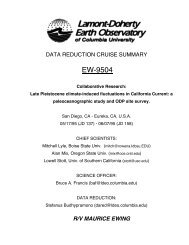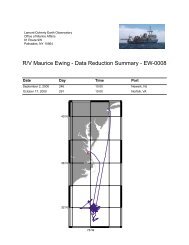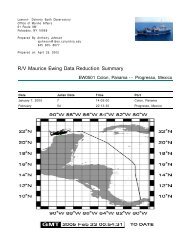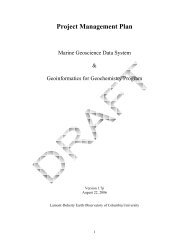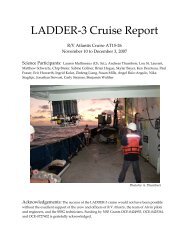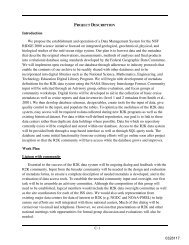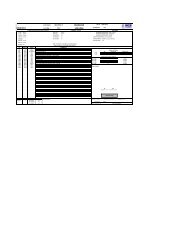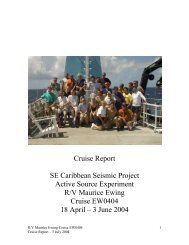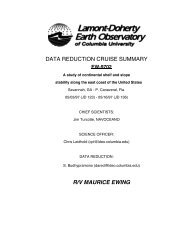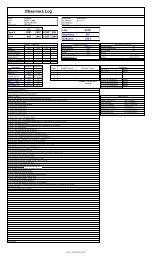in a comprehensive bathymetry image of the area, as shown in figure 27 that shows the morphology of theseafloor right in front of the ice shelf in great detail. Much of the remaining unmapped area is shallow andincludes small islands, or access was blocked by sea ice and icebergs.Updated Amundsen GridThe new bathymetry data collected during this cruise will be used to update the existing bathymetrycompilation of the Amundsen Sea (Nitsche et al 2007). Beside the Pine Island Bay trough, improvements ofthe overall bathymetry image were made along most of the cruise track, especially in the outer shelf region,and the central ridge separating the Pine Island-Thwaites trough system from the Getz trough system (Fig.28).6.5 Results: Sub-Bottom ProfilingDuring the cruise the Bathy2000 sub-bottom data were mostly used as an additional source for bathymetricdepth information. We did not perform a systematic analysis of the sub-bottom data during the cruise,but they are digitally available and will aid the interpretation of morphological features identified in theswath-bathymetry mapping.Nitsche, F.O., Jacobs, S., Larter, R.D. and Gohl, K., 2007. Bathymetry of the Amundsen Sea ContinentalShelf: Implications for Geology, Oceanography, and Glaciology. Geochemistry, Geophysics, Geosystems, 8:Q10009, doi:10.1029/2007GC0<strong>01</strong>694.7 Onboard numerical modelingChris LittleA modified version of the Hallberg Isopycnal Model (HIM) was used to aid the interpretation of oceanographicprocesses under the Pine Island Ice Shelf (PIIS). An idealized ice shelf shape based on earlier studieswas gradually modified to represent PIIS. Although only the most ”realistic” model run is presented, thosefindings highlighted here are relatively insensitive to details of cavity shape and oceanic forcing. The numericaldomain employed in this simulation was 80x100 km, discretized on a 1 km horizontal grid. The oceanconsists of 10 isopyncal layers coupled to a bulk mixed layer; the depth of the ”mixed” layer is determinedby a turbulent kinetic energy budget. Ice-ocean fluxes through a viscous sub-layer parameterization aregoverned by mixed layer temperature, salinity, and flow speed.7.1 Bathymetry and Ice ThicknessThe water column thickness – depth of ocean floor minus the depth of the ice shelf base, if present – for thissimulation is shown in figure 29. Bathymetry was derived from multibeam maps of Pine Island Bay and from”BEDMAP” where bathymetric data were unavailable (i.e. underneath PIIS). The model’s ice shelf draftwas derived from BEDMAP ice thickness data assuming a constant ice density (0.917 kg m −3 ); the groundingline is located where the floating ice thickness is less than the bedrock depth. The lack of bathymetry andice thickness data in the ”northern lobe” of PIIS makes its role in the sub-ice shelf circulation difficult todetermine.Higher resolution datasets show evidence that PIIS is heavily crevassed, and previous studies indicate thatsub-ice topography influences flow. To illuminate the effect of inverted basal channels of different dimensions,<strong>NBP09</strong>-<strong>01</strong> <strong>Cruise</strong> <strong>Report</strong> (p. 46 of 83) Revised February 27, 2009
Figure 29: Water column thickness (m) over the model domain.the ice shelf draft was altered by an increment that varied sinusoidally transverse to the longitudinal axis ofthe ice shelf. This alteration modified the ice shelf draft (contours in figure 30) by up to ∼100 meters.7.2 Model ForcingThe model simulation was initialized with a meridionally uniform temperature and salinity profile correspondingto <strong>NBP09</strong>-<strong>01</strong> CTD 14. Flow was initiated and maintained by buoyancy fluxes at the ice-oceaninterface. No winds or tides were prescribed. During the simulation, the hydrography was restored to theinitial conditions in the western 15 km. The model was integrated for 20 days, at which point the kineticenergy of the flow stabilized. The strong restoring may have limited accurate representation of the locationof inflow as well as ice front hydrography. When more computational resources are available, that sensitivitywill be explored.7.3 Preliminary ResultsGiven our still limited knowledge of ice shelf basal topography, sub-shelf bathymetry, and forcing, modelresults are primarily qualitative. However, there is encouraging agreement between the observed and modeledocean circulation and melting patterns. In figure 30, heightened melt rates occur in three distinct locationsdriven by differing dynamics: near the deepest parts of the ice shelf grounding line, near the ice shelf front,and in inverted channels at the ice shelf base.The depth integrated flow illustrated in figure 30 obscures vertically sheared currents underneath the iceshelf. Heat used for melting is derived primarily from the densest, warmest waters respresented in thesimulation (CDW); virtually all heat entrained into the mixed layer occurs within 10 km of the grounding<strong>NBP09</strong>-<strong>01</strong> <strong>Cruise</strong> <strong>Report</strong> (p. 47 of 83) Revised February 27, 2009
- Page 3 and 4: List of Figures1 Regional map of CT
- Page 5 and 6: Universities and to Raytheon Polar
- Page 8 and 9: 1, 7, 104, and 159. At least one ad
- Page 10 and 11: and dissolved oxygen decreasing wit
- Page 12: Primary-Secondary O2 sensor differe
- Page 15 and 16: Run Test 1 2 3 4 5 6 7 8 9 10 11Stb
- Page 17 and 18: In order to estimate the accuracy o
- Page 19 and 20: ice-ocean boundary layer. To do thi
- Page 21 and 22: Figure 17: Using small boat for rec
- Page 23 and 24: Figure 19: Planned mission profiles
- Page 25 and 26: was under way (Figure 17). This met
- Page 27 and 28: # Starttime, pos,duration, km427428
- Page 29 and 30: S. Jacobs O-274-N Mooring Schematic
- Page 31 and 32: at the helm.The high iceberg produc
- Page 33 and 34: Seasonal sea ice changes in the Amu
- Page 35 and 36: in the Amundsen Sea - (1) the confi
- Page 37 and 38: An automated camera system provided
- Page 39 and 40: presence of ice layers and wicked b
- Page 41 and 42: enough number to be able to regiona
- Page 43 and 44: 6 Seafloor MappingFrank Nitsche, Ka
- Page 45: Due to the location of the transduc
- Page 49 and 50: Figure 31: A south-to-north cross s
- Page 51 and 52: phytoplankton from the upper 200m w
- Page 53 and 54: uptake (K m ) as well as the maximu
- Page 55 and 56: Elmer UV/VIS Lambda 18 spectrophoto
- Page 57 and 58: Figure 37: Section plot of dissolve
- Page 59 and 60: ligand ’TAC’ (2-(2-Thiazolylazo
- Page 61 and 62: Both GA and PA, at times, resulted
- Page 63 and 64: 9 Other Sampling and Profiling9.1 O
- Page 65 and 66: Figure 42: XBTs gridded as if they
- Page 67 and 68: on them. A single hollow column is
- Page 69 and 70: in ways that are accessible to a wi
- Page 71 and 72: AppendicesACruise ParticipantsPerso
- Page 73 and 74: BCTD Station TableNo. Date Time Lat
- Page 75 and 76: continued from previous pageNo. Dat
- Page 77 and 78: CPre-cruise Project PlansC.1 Amunds
- Page 79 and 80: Figure 48: Missions, three each, pe
- Page 81 and 82: C.4 Collaborative Research: Samplin



